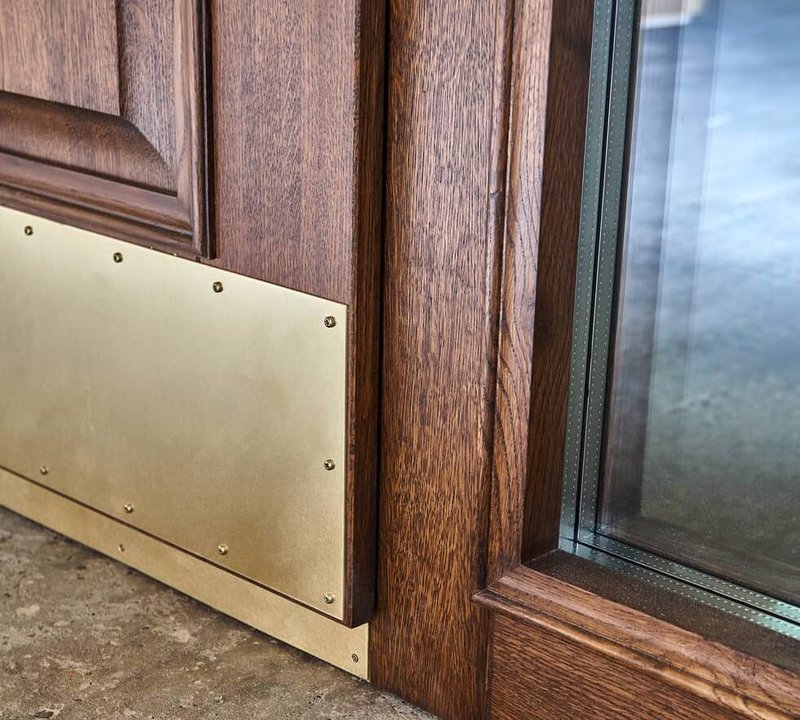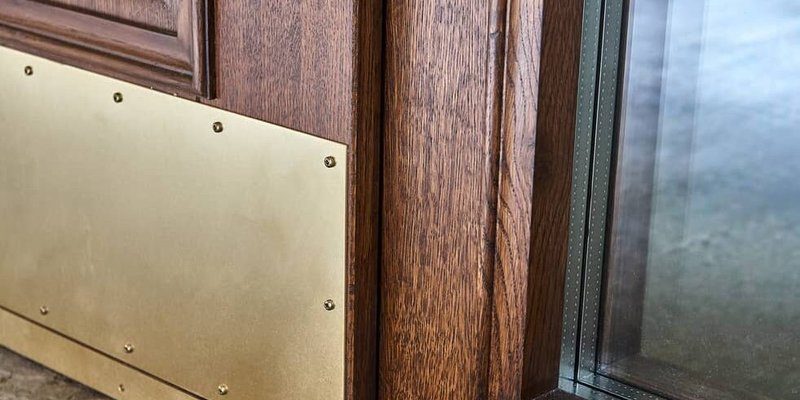
Dealing with this issue is a little like tracking down a leaky faucet. It’s not always clear where the rust starts, and there are a surprising number of ways it can go wrong—whether you have a classic brass kick plate from Schlage, an aluminum model, or something painted to match your door. But here’s the thing: you don’t have to settle for rust stains or rip off your kick plate in frustration. With a little know-how, patience, and the right troubleshooting steps, you can figure out what’s causing the rust, stop it, and keep your door looking sharp.
How Rust Stains Form on Thresholds From Kick Plates
Here’s what’s really happening under the surface. Most kick plates are made from metals like brass, stainless steel, or aluminum. Even if they’re marketed as “rust-proof,” that’s often more like “rust-resistant.” Over time, water from rain, snow, or just hosing off your porch can sneak between the kick plate and the door. Combine that moisture with oxygen, and you’ve got a perfect recipe for corrosion.
You might be wondering, “My kick plate still looks shiny—how is it causing rust?” Well, rust doesn’t always show up on the part of the kick plate you can see. Sometimes, the back or the edges (where the metal isn’t properly sealed or the paint’s chipped) are where corrosion starts. Water seeps in, reacts with the metal, and the resulting rust leaches down onto the door’s threshold, where it leaves those unmistakable orange stains.
Some brands, like Baldwin or Schlage, use higher-quality materials, but even then, a scratch, a loose screw, or a gap in the seal can start the process. Honestly, no metal is completely safe if the conditions are right—or wrong, depending on how you look at it.
Identifying the Cause: Kick Plate, Screws, or Threshold?
Before you start scrubbing away at those stains, it’s smart to play detective. Not all rust stains are caused by the kick plate itself. Sometimes, the screws used to attach the plate (often made of cheaper steel or a different metal than the plate) start to corrode first, especially if they’re not stainless steel or have lost their plating.
Here’s what I recommend for diagnosing the issue:
- Check the back of the kick plate. Carefully unscrew and remove the plate. If the reverse side is showing spots of rust or pitting, there’s your first clue.
- Inspect the screws or fasteners. Are they rusty or leaving residue behind? Replace them with stainless steel if needed. Mixed metals (like brass plate with steel screws) can lead to faster corrosion due to galvanic reactions. Yes, it’s as chemistry class as it sounds.
- Look at the threshold itself. If the threshold is metal, it could be corroding independently, especially if it’s older or exposed to a lot of moisture. Wood or composite thresholds can stain if they absorb rusty water.
- Check for water intrusion. Gaps between the door and threshold, or beneath the plate, let water in and trap it—set up for rust every time.
If you spot rust on just one screw or along one edge, don’t ignore it. Corrosion loves company, and it tends to spread if left alone.
Cleaning Rust Stains Safely Without Damaging the Threshold
So the stains are there—now what? The trick is to get rid of the rust without making things worse. Aggressive scrubbing or harsh chemicals can strip paint, pit metal, or leave lasting marks. Nobody wants a shiny door with a scratched-up threshold.
To clean rust stains off a threshold, here’s a safe, step-by-step approach:
- Test a small area first. Pick a corner or hidden edge, especially if the threshold is painted or coated.
- Use a mild acidic cleaner. Lemon juice or white vinegar often does the trick. Dab it onto the stain, let it sit for a few minutes, then gently scrub with a soft-bristled brush or cloth. For tougher stains, a baking soda paste works as a gentle abrasive.
- Rinse and dry thoroughly. Water is the enemy, remember? Dry every nook and cranny when you’re done.
- Avoid harsh metal brushes. They can create scratches where future rust will love to grow. Stick to plastic or nylon bristles.
If you’re dealing with an aluminum or painted threshold (common with Pella or Therma-Tru door setups), be extra gentle. You can always do another round of cleaning—overdoing it once can cause permanent damage.
For deep, stubborn stains, commercial rust removers made for household use often help, but always check that they’re safe for your specific material.
Treating and Preventing Future Rust at the Source
It’s one thing to clean up rust, but that’s only half the battle. If you don’t tackle the cause, you’ll be scrubbing again sooner than you’d like. Here’s where a little preventative maintenance pays off.
First, once the kick plate is off, clean it thoroughly and dry it. If you see rust forming on the back or edges, use fine steel wool or a wire brush to remove it, then wipe everything down. For extra protection:
- Apply a rust-inhibiting primer or clear coat to the back of the kick plate before reinstalling it.
- Seal any gaps around the plate with a thin bead of clear silicone caulk to keep out moisture.
- Swap in stainless steel, brass, or coated screws if your current hardware is rust-prone.
Some homeowners swear by putting a thin gasket (even just a strip of weatherproof foam tape) between the kick plate and the door or threshold. It’s a little detail, but it blocks water and keeps metal from touching metal, which slows down corrosion.
Keep in mind, this isn’t just about looks—a rusty threshold can actually trap water against your door frame, which leads to swelling, rot, and all sorts of other headaches.
Choosing the Right Kick Plate to Avoid Rust Problems
If your kick plate is past saving or you’re just tired of the maintenance, it might be time to upgrade. Not all kick plates are created equal, and choosing wisely up front is the easiest way to avoid future rust stains.
When shopping, here’s what to look for:
- Material matters. Solid brass, stainless steel, and high-grade aluminum plates hold up best. Avoid anything with a thin plated or painted finish unless it specifically says “marine-grade” or “weather-resistant.”
- Finish type. Some finishes, like powder coating, offer better protection than plain paint or lacquer. Polished or mirror finishes are harder to keep looking good outdoors, honestly.
- Brand reputation. Brands like Baldwin, Schlage, or Deltana are usually safer bets for quality and longevity, though no option is 100% maintenance-free.
If your threshold is especially exposed to the elements, consider skipping the kick plate altogether or switching to a composite model. Some newer “universal” plates fit most residential doors and use plastic fasteners, so you don’t have to worry about mixed metals rusting in the first place.
Addressing Sill and Threshold Maintenance
Don’t ignore the actual threshold in your troubleshooting. Even if you swap out the kick plate, a damaged or corroded threshold will keep giving you problems. Over time, sills and thresholds lose their finishes, start to pit, or trap water in places you won’t see until there’s a bigger issue.
Here’s how to keep yours in shape:
- Clean and inspect regularly. Every few months, give it a quick wipe-down and check for soft spots, discoloration, or loose screws.
- Re-coat or seal wooden or metal thresholds. Use exterior-grade sealants or paint as needed, especially if you see bare spots forming.
- Keep gutters and door sweeps working. If water pools around your door after every storm, no kick plate or threshold will last long. Redirect water and check your weatherstripping.
If you’re seeing repeated rust stains, run a quick check with a level—sometimes, a threshold is tilted in a way that collects and holds water right under your kick plate, making rust inevitable. Fixing the grade or adding a drip edge can solve that for good.
When to Replace vs. Repair a Kick Plate or Threshold
You might be wondering if it’s time to throw in the towel and buy something new. It depends on the extent of the damage. If your kick plate only has light surface rust, you can usually clean and protect it. But if you can see pitting, holes, or if the plate bends when you take it off, it’s probably not worth saving.
The same goes for the threshold:
- Minor stains or chips? Clean, patch, and seal them.
- Deep rust, rot, or structural weakness? It’s time for a replacement. Don’t wait until it gets worse—water damage only spreads.
Luckily, most residential kick plates and thresholds are easy to find at home improvement stores. Measure carefully, bring in the old part if you can, and match the finish to avoid a mismatched look. A universal design often works if you can’t find an exact brand match.
It’s better to do a full swap once than to keep re-cleaning every few months. Newer materials are made to last longer and require less babying.
Simple Maintenance to Prevent Rust Stains in the Future
Let me explain why ongoing maintenance matters, even if everything looks fine now. A quick five-minute check every season can catch small issues before they become big rust stains (or expensive repairs).
Here’s a simple routine:
- Wipe down the kick plate and threshold after storms. If you notice pooling water or dirt, clean it off right away.
- Check fasteners and edges. Tighten loose screws and make sure no gaps are forming along the seams.
- Reapply protective sprays or coatings. Once a year, a coat of clear sealant can make a huge difference.
If you spot the first sign of rust, tackle it the same week. The longer rust sits, the deeper it stains, and the harder it is to fix.
Closing Thoughts: Keeping Entryways Sharp and Rust-Free
Dealing with a kick plate that’s causing rust stains on your threshold might feel like a minor hassle, but it says a lot about how well your home’s entryway stands up to the weather. With a little patience, some simple troubleshooting, and the right materials, you can stop rust before it becomes a persistent eyesore. Ultimately, a little maintenance now saves you time, money, and frustration down the line—and keeps your doorway looking every bit as welcoming as you want it to be.
